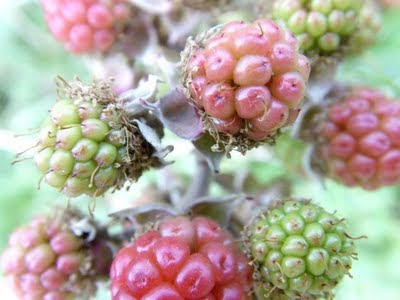blackberries on Brean Down

Some photos we took at the same time as the last lot from Brean, back in August. Like most average citizens I am content to know that there are 276 microspecies of Rubus fruticosus agg. in the UK, without being able to distinguish a single one. But sometimes I'm in a different place and the blackberries look a bit different from usual, and then I think, this lot have got to be one of the microspecies I don't usually see. And I feel obscurely pleased, as by the first stirrings of a sense I didn't know I possessed and will almost certainly never develop.
Development might begin, for instance, by analyzing WHY they struck me as a bit different. But I never got as far as that. The only answer I could give would be: well, I noticed them. Blackberries, as a rule, are not something I notice. Pink flowers though, not white ones. Neat-looking fruit borne on the top of the thicket, many segments, many stamens.... Naturally, the windswept coastal conditions would also affect the overall look of the plant and this might not imply any microspecific significance.



Labels: Plants


2 Comments:
Ah, yes, I have vaguely noticed over the years that they vary a lot. I don't believe there can still be 276 microspecies because surely they only got that way through promiscuous miscegenation, and new kinds of quadroon, octoroon etc must be germinating as we speak. Is this not an anomaly of botanists (or their journalistic tendencies) rather than the species they study?
I believe there is a similar diversity in wild mints. I wanted some peppermint for the garden and one day on a remote Chiltern hillside I gathered samples from meadow and woodland path, which had an interesting aroma of peppermint and Parma violets. As an infusion the leaves tasted disgusting, though. It seems peppermint like homo sapiens sapiens doesn't like staying "racially pure".
Well,no. The botanists are sort of right on this, though there is disagreement about the terms, because the everyday rule-of-thumb for a species breaks down to a certain extent, since deciding whether different blackberries can or cannot interbreed is a matter of definition. Promiscuous is what they aren't.
As far as I understand it, blackberries are overwhelmingly apomicts - i.e. they produce fruit which is entirely female in origin, though to make it weirder they are pseudogamous, which means that they require pollenation to trigger this (even though they don't make any use of the male pollen). Therefore any genetic difference that occurs (e.g. because of rare sexual congress or rare genetic miscopying)will then be reproduced in subsequent generations. Over the milennia this leads to hundreds of minute local variants that do not disappear but stay true and can be distinguished by specialists.
If you add in all the blackberries that seem to show some hybrid lineage from raspberry or dewberry, there are over 400 altogether. You are right in saying that, in the long view, none of these microspecies is going to persist forever in its current form, but that is the same for all living creatures - a species, no less than an individual, is a transient appearance.
Mints are another very tricky lot, as you noticed. The issue here, I think, is that the species have diverged so little that all combinations of fertile hybrids (and their qualities) may be encountered. Being generally anosmic, I rarely have the opportunity, alas, to experience the different scents of peppermint, spearmint, eau de cologne mint, apple mint, the sickly-scented round-leaved mint, pennyroyal...
Post a Comment
<< Home